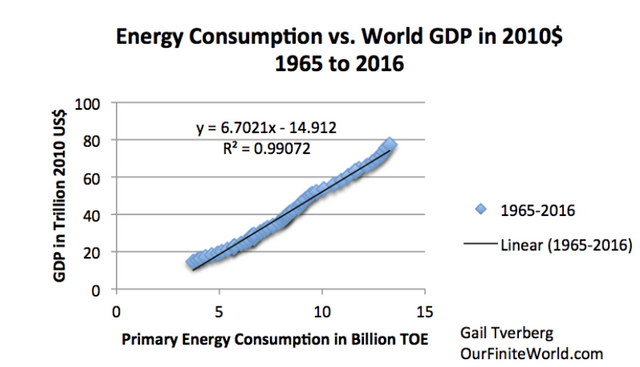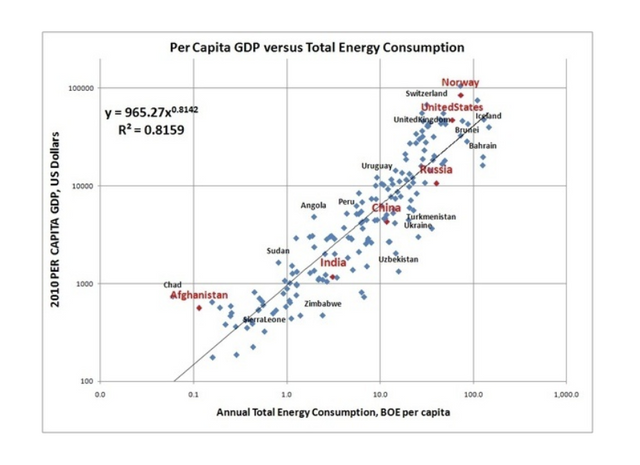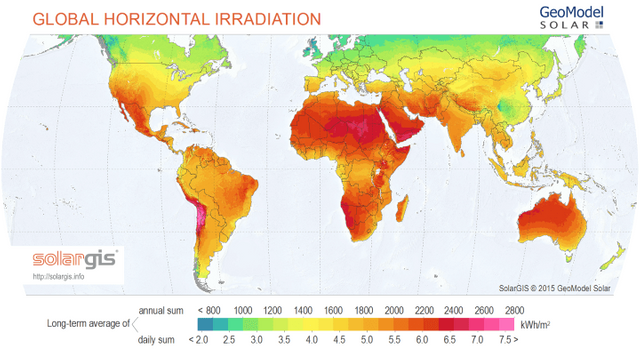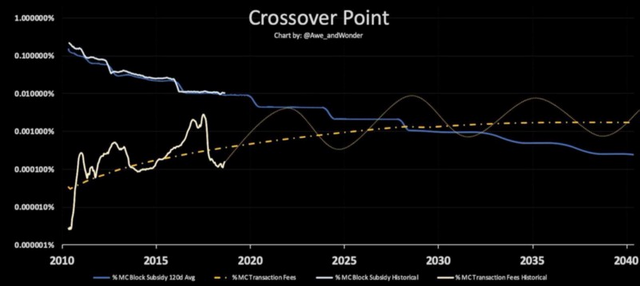RE: Secrets of Bitcoin’s Dystopian Valuation Model
Proof-of-work Fundamentally Changes the World
Click here to zoom this comment post to full-width in the browser window.
[…] and Bacon's insistence that nature had to be tortured to release its secrets
Proof-of-work will peak in value when the opportunity cost for investing in mining becomes greater than investing in other activities in the economy.
Proof-of-work is globalized deflation of unproductive sectors until proof-of-work’s valuation peaks (or rate of increase slows sufficiently), because until then there's no economic incentive to invest in anything other than mining and its following constituents unless that other investment has a ROI greater than
≈10Xevery 4 years (or whatever the former slows down to):- proof-of-work generated tokens
- mining
- electricity generation
- mining hardware
- silicon fabs
- engineering for the above
The deflationary impact of proof-of-work will (very soon) be analogous to the oversupply of agricultural labor in the Dark (Middle) Ages,which was only resolved by the Black Death which euthanized more than half of the world’s population and perhaps up to ⅔ of Europe’s. Usury didn’t exist during that time not only because of the widespread Catholic religion but also because there was no economic incentive to loan money because of the structural deflation due to an unemployable population.Nevertheless the world GDP will grow (but more focused in the above enumerated sectors) because GDP growth is correlated to energy consumption which must increase (and by implication countries which tax proof-of-work mining† and otherwise retard electrical consumption growth will experience reductions in GDP):


In some sense we may now view the only purpose of the human race at this juncture is to maximize consumption of energy (and integrated circuits) at higher economies-of-scale and efficiencies (c.f. also, also and also).
† Mining taxation which seems implausible because mining farms can be structured as service providers which mine BTC for clients outside the tax jurisdiction.
Proof-of-work may actually reduce the cost of electricity via economies-of-scale, instead of being inflationary! Yet as explained below, any negative effects on the general population may be worse in colder, less sunny climates.
The differences in the types and production costs of electrical energy and diurnal/seasonal/business-cycle variation in demand seem to be critically important for understanding the coming economic effects of proof-of-work. Proof-of-work adds efficiency because it offsets insufficient demand (from surplus generation supply) that would otherwise have gone to waste and enables efficiencies in production because electricity generation can be put in the most efficient locations and at high economies-of-scale without the transmission costs to population centers because the value can be transferred via proof-of-work mining.
Also stumbled onto the following amazing claim which is explained by an MIT study:
Photovoltaic prices have fallen from $76.67 per watt in 1977 to nearly $0.13 per watt in May 2019, for crystalline silicon solar cells and module price to $0.23 per watt. This is seen as evidence supporting Swanson's law, which states that solar cell prices fall 20% for every doubling of cumulative shipments. The famous Moore's law calls for a doubling of transistor count every two years.
By 2011, the price of PV modules per MW had fallen by 60% since 2008, according to Bloomberg New Energy Finance estimates, putting solar power for the first time on a competitive footing with the retail price of electricity in some sunny countries; an alternative and consistent price decline figure of 75% from 2007 to 2012 has also been published, though it is unclear whether these figures are specific to the United States or generally global.
In the year 2015, First Solar agreed to supply solar power at 3.87 cents/kWh levelised price from its 100 MW Playa Solar 2 project which is far cheaper than the electricity sale price from conventional electricity generation plants. From January 2015 through May 2016, records have continued to fall quickly, and solar electricity prices, which have reached levels below 3 cents/kWh, continue to fall. In August 2016, Chile announced a new record low contract price to provide solar power for $29.10 per megawatt-hour (MWh). In September 2016, Abu Dhabi announced a new record breaking bid price, promising to provide solar power for $24.2 per MWh In October 2017, Saudi Arabia announced a further low contract price to provide solar power for $17.90 per MWh.
Unless there are mitigating circumstances (c.f. below), lowest-cost proof-of-work mining requires electricity that is generated 24 hours a day, because electric storage is too expensive. So the economics of solar are very interesting because it can’t be a primary source for proof-of-work mining.
My blog implied that as proof-of-work consumes more of the lowest-cost electricity, the amount of marginal proof-of-work mining increases proportionally. This will drive up the demand for higher-cost electricity (at least in colder, less sunny climates). But the daytime demand for electricity can be fulfilled at decreasing costs by solar in sunny locations (and especially warm locations where mining is less efficient and presumably mining demand is less because additional energy for cooling is needed due to the warmer climate).


Thus the cost of electricity in warmer, sunny climates for daytime use might decrease especially if proof-of-mining electrical demands are partially met by increasing economies-of-scale in solar power. Electricity costs in colder climates will increase significantly, unless mining is discouraged; in which case the GDP will decline. Combine this inflationary economic effect on colder venues with the deflationary effect of the coming Maunder Minimum and Global Cooling into a Mini-Ice Age. Note as solar power becomes significantly less expensive than other forms of electrical generation, sunny climates at high elevation that have year round cool and cold climates might be cost-efficient for proof-of-work mining either coupled with reasonable cost utility power at night or perhaps mining only in the daytime by deploying second-hand, older generation, less expensive mining equipment.
I’ve changed my mind. Proof-of-work isn’t evil money. Instead it’s a technological improvement ofJohn Nash’s Ideal Money conceptualization,because it objectively values relative work.Proof-of-work has a natural limit to valuation appreciation when the relative potential increase in value of human work is greater than the relative potential increase in electrical generation possible at an equivalent cost of capitalization. Naturally as the quantity of electrical generation increases, the amount of capital required to make proportional increases in electrical generation increases disproportionately. Thus there must be some level at which human work generally becomes economic again.Also I have a very strange psychological effect (perhaps due to all the hallucinations my illness has caused), in that it seems like this entire comment is a replay from something I had already realized before but temporarily forgotten. I was deeply analyzing proof-of-work algorithms and economics in the past such as in 2013. Perhaps I read or on my own deduced something that was similar to what I’m writing now. But my discombobulated mental (Tuberculosis, treatment, autoimmunity, diseased liver and spleen, etc) state since 2013 has caused a lot of amnesia and interrupted, disconnected thought processes.
The dilemma is that proof-of-work will economically enforce the objective value of humanity. Given that the vast majority of humanity is worth much less than they realize, pumped up with debt and worthless skills,
this objective valuation will drive a Dark Age of unemployment, especially in the Western (colder, less sunny) nations.Thus we can be nearly certain that massive social unrest and war is coming. Also we can be nearly certain that the desperate “wealthy” (less productive, overvalued, Western) nations will attempt to confiscate the wealth they thought was theirs. Ultimately the nations will be driven to a world government in order to coordinate their globalized wealth taxation.Satoshi’s immutable real Bitcoin can do roughly 1 million simple transactions per day. So the following table of possibilities correlates to the percentage of market capitalization for transactions fees depicted on the chart in §Projecting Bitcoin’s Transaction Fees of my blog:
Daily % of MC Marketcap
($trillions)Simple Txn Fee Year 0.0001%0.001$0.00120110.0001%0.01$0.0120130.0001%0.1$0.120170.0001%1$120210.0001%10$1020250.0001%100$10020290.0001%1000$100020330.001%0.01$0.120130.001%0.1$120170.001%1$1020210.001%10$10020250.001%100$100020290.001%1000$10,00020330.01%0.1$1020170.01%1$10020210.01%10$100020250.01%100$10,00020290.01%1000$100,00020330.1%1$100020210.1%10$10,00020250.1%100$100,00020290.1%1000$1,000,0002033For Litecoin multiply the values for Marketcap by
0.0725and for Txn Fee by0.0725 ÷ 4 = 0.018125. So clearly we can see that SegWit and Lightning Networks (LN) will be more viable on Litecoin.Transaction fees will be set where demand meets supply for the most marginal of the wealthy who can fit on-chain. Given there are roughly 36 million millionaires (including billionaires) in the world and Bitcoin can do 365 million simple transactions per year, it seems about correct that eventually only “millionaires” will be able to transact on Bitcoin. So that 0.5% of the population controls roughly $100 trillion in wealth which is roughly 30–40% of the world’s wealth. There are roughly 20 million $1 million-millionaires (not including billionaires) in the world.
I’ll guesstimate that these $1 million-millionaires don’t want to spend more than say 1–5% of their net worth annually to remain on-chain. Perhaps 100 million or more lower net worth individuals will be completing to stay on-chain and presuming desperately (if no suitable alternative) willing to spend perhaps even up to 5–10% of their net worth annually in fees. Thus my guess is when Bitcoin reaches $100 trillion market capitalization (i.e. > $5 million per BTC),
that the annual transaction fees can’t be less than $1 trillion, perhaps as high as $2 trillion. That’s roughly0.01%of MC daily, which is why I have emphasized that line with bold text in the above chart.That would be roughly 10,000 to 20,000 TWh/year of electricity consumption by roughly 2029, which would be 50–100% of current world electricity consumption.Therefore, isn’t true that—a proof-of-work cryptocurrency with a hard limit on the tokens to ever be mined (e.g. 21 million BTC)—has less “effective debasement” for all users after it’s all been mined, than a hypothetical proof-of-work cryptocurrency which has a perpetual minted mining reward (e.g. 1–2% analogous to gold) but no significant transaction fees (perpetual reward being necessary to fund mining in absence of txn fees), because some users may spend often enough and/or in small enough amounts that the projected Txn Fee is greater than said perpetual debasement. Ongoing security must be paid either by debasement or txn fees—the former asymmetrically rewarding transactional quiescence and/or highly valued transactions which is antithetical to prosperity. IOW, the flaw of Bitcoin/Litecoin seems to be the end game where ideally minting should stabilize at some level, but instead continues halving because it’s unknowable at what level the free market will decide #1 above. In my next blog I will discuss theories about thus how proof-of-work may become incentives incompatible and/or centralize due to the loss of Nash equilibrium.
Advantage of said hypothetical is no one is kicked off-chain. After Bitcoin kicks all but the top 5% of net worth off-chain, the remaining 95% with 15% of the world’s wealth will otherwise end up transacting off-chain with something not-trustless like Lightning Networks (LN) (on Litecoin) suffering opaque fractional reserves that demand regulation by a government and central bank. The alternative (e.g. Litecoin with SegWit/LN) to the said hypothetical seems to be an incomplete, non-idealized step towards trustless, decentralization. However others might argue the minions aren’t worthy and deserve to be fleeced by elite wolves who know better. Yet from the pool of minions nature often selects new elite. Objective forward economic mobility seems to be as important to the symmetric objectivity of the march of maximum entropy.

You should just be able to see it unencrypted by using the memo private key or simply opening your wallet as if you were doing a Steem transfer. The question is kind of moot at this point AFAIC since I'm not vulnerable, but I thought that anything with more than about 6 confirmations is pretty much set in stone (segwit or not). I've noticed that certain high profile OG's (such as John McAfee and Andreas Antonopoulos) still use the old address format (hmmmmm). Not sure how stripping transactions that start out with a 3 would work from the miners perspective unless of course it was a 51% attack or within the 6 confirmation threshold.
Makes me wonder if McAfee is still a state operative or he really has gone rogue.
PS - I was under the impression that mining having centralized to electrical plants in (places like China in 2017) were using their excess electricity (what would have been forced waste) on bitcoin mining for profit and that there was no storage of electricity necessary.
PPS - I noticed that sometime back around 1987 the rules for credit changed and everybody was getting credit cards (something I was unable to do before that time). I'm aware of the history that has gone against bankers for centuries because usury is a sin. Very interesting reading your blogs are. I've had some time to get through several, but it is densely packed material. Will take time to digest. Thanks!